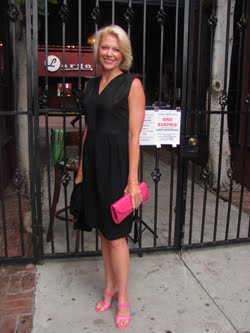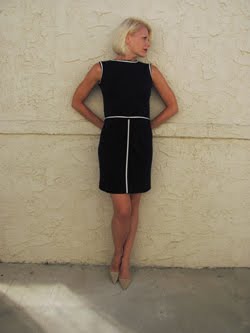From the earliest days of her career in America, Marlene was known for her unique and often groundbreaking style. She knew the character she wanted to be both on and offscreen, and passionately controlled her look. Though Marlene was clearly in charge, her style emerged largely as the result of her relationship with two men--director/mentor/lover Josef von Sternberg and Paramount's head costume designer Travis Banton. Together they collaborated to create the iconic style of movies like Morocco (1930)--where Marlene wore a tuxedo, kissed a girl, and brought menswear to the fashion mainstream--and the ever exotic Shanghai Express (1932). As Banton's one-time assistant, Edith knew Marlene very well. They shared a strong work ethic and routinely spent days together for fittings (when most stars balked at a few hours) as well as trying different combinations of feathers, veils, and other accessories to conjure the right effect. Marlene even had a bodysuit created--long before there was such a thing as Spanx--to sculpt her entire figure the way she wanted. Her dedication was such that she ignored the intense pain this undergarment and other tricks of her trade--such as tiny tight braids woven along her hairline for a temporary facelift--in order to always achieve the perfect look.
Wilder loved everything about Marlene, including this level of commitment to her career. Though the feeling was mutual--they were very close during this time--A Foreign Affair was not a picture that she wanted to do. At all. As Erika von Schluetow, the role would require her to play a Nazi...and the girlfriend of a Nazi. The very deutsch Dietrich had worked tirelessly from the onset of World War II to distance herself from ever being associated with that lot. She publicly rebuked Adolph Hitler when he made very personal requests for her to return to Germany. She also turned down lucrative contracts from his equally eager Minister of Propaganda, Joseph Goebbels, who controlled the press as well as entire German entertainment industry. Instead, in 1939 Marlene proudly became an American citizen. She then joined the first of several tours with the USO starting in the early 1940s. On her last tour, she even crossed enemy lines into Germany with General George S. Patton in order to perform. Because she subjected herself to such danger--"out of decency," she said--and appeared before hundreds of thousands of US troops, Marlene was awarded the Medal of Freedom in 1945. It was the moment she would always consider her highest honor.
With all this behind her, it's easy to understand Marlene's repeated and emphatic NO. Wilder could even empathize further...being a fellow German who found himself forced out of the country with the rise of Hitler. But he still felt this part was perfect for her and tried everything he could. First, he tempted her with Frederick Hollander, the composer who wrote Marlene's music in her break-through The Blue Angel (1930). He would write three more songs just for her in A Foreign Affair. Then, because Marlene's magnificent ego could also be her Achilles heel, Wilder stirred a little competition by screen testing another actress--June Havoc. Using their friendship and asking her advice, he visited Marlene in Paris to go over June's attempts at Erika von Schluetow together. Criticisms flew from her for days. However, every moment that her indignation grew, her great resolve was weakened. Finally, acting as if he received some divine inspiration, Wilder dramatically declared, "Marlene, only you can play this part!" Clearly, she agreed.
Wilder had happily won his star, but he had not necessarily addressed all of her anxieties about the role. What's fascinating about A Foreign Affair is how its costume design would come to do just that. While Edith Head is responsible for most of the film's wardrobe--including Jean Arthur's tailored suiting and some super sexy trench coats for Marlene--the standouts are three showstopping gowns courtesy of Irene Lentz Gibbons. Known simply as Irene, she would rival Edith in Hollywood when she became head of costume design at Metro-Goldwyn-Mayer (MGM). But before MGM, Irene headed costume design at the historic Bullocks-Wilshire department store. It was there that nearly every single movie studio turned to her to supplement their costumes for films, starting with RKO's Flying Down to Rio in 1933 (which, coincidentally, is the other movie I introduced at the TCM film festival). She was so renowned for her timeless design and meticulous construction that nearly all of Hollywood's leading ladies turned to Irene for their offscreen wardrobes as well. Marlene happened to be such a fan that clothes from Irene remained in her closet throughout her life. It's not a surprise, then, that she would ask Irene to design the gowns for her beloved tours with the USO. Her 'illusion' gowns, in particular--so named for the nude effect from strategically placed sequins and beads--gave our war-weary soldiers just the excitement they needed.
Years later, three of her gowns from the USO tours would appear again in A Foreign Affair. For the songs "Black Market" and "Illusions," Marlene wears her two longsleeve 'illusion' gowns. For the film's final rousing "Ruins of Berlin," she stuns in her strapless paisley gown, which Edith decorated with flowers to echo the lyrics of the song. Though the dresses were perfect for the purpose of torch singer Erika von Schluetow--character being the most important part of costume design--they also served another goal. There's no question in my mind this was Marlene's way of reminding the audience just who she was and what she stood for. After all, pictures of these gowns at the USO appeared in publications all over the world (like LIFE magazine, as you'll see below). So every time she struts on screen in A Foreign Affair in those stunning numbers at the Lorelei nightclub, it is yet another finger at the Third Reich.
A Foreign Affair is great example of how stories behind the style can bring so much to film appreciation. It's also yet another lesson in classic cinema's connection to fashion. After this film, Marlene's style was forever associated with 'illusion' gowns. In fact, they became one of the clever tools she used as she aged. She would turn to Jean Louis (Gilda, Pillow Talk) in the early 1950s to design equally influential 'illusion' gowns for her famed Las Vegas cabaret act. Today, fashion designers continue to refer to these gowns again and again. Fans include Michael Kors, Jean Paul Gaultier, and Zuhair Murad who created Jennifer Lopez's lace 'illusion' gown for the Golden Globes and 'illusion' costumes for her current world tour. These are just a few examples. As a result, though A Foreign Affair may be one of Billy Wilder's lesser known films by name, this is certainly not the case with its style. The legacy of Marlene Dietrich and how she mastered illusion in these gowns will go on forever in both fashion and film.
Cinematographer Charles Lang (Sabrina) is so talented
he even makes war-ravaged Berlin look beautiful
Our introduction to Erika von Schluetow in A Foreign Affair wearing a polkadot robe by Edith Head...
only Marlene can make spitting toothpaste at a lover (John Lund) so hot
"Black Market"
Marlene comes to life in the movie on stage at the Lorelei...
first, in her longsleeve metallic sequin 'illusion' gown by Irene
Frederick Hollander, composer for Marlene in 1930's The Blue Angel,
joins her on screen for his original song "Black Market"
The illusion of this Irene gown is extremely effective, especially with her custom-made corsetry...
co-star Lund gives Marlene more than an admiring eye as her lover Captain John Pringle
Years before A Foreign Affair, LIFE magazine captures Marlene in her illusion gown
being admired by soldiers during her 1945 USO tour in Germany
"Illusions"
Marlene sings Hollander's "Illusions" while appropriately wearing yet another illusion gown...
this one included a peplum and white sequins to look like lace
Jean Arthur in a gown by Edith Head (which is meant to be over-the-top for her character)
while Marlene sexes things up in Irene
In 1942, LIFE magazine caught Marlene surrounded at New York City's Astor Hotel (above)
and performing on a piano in Europe on the USO tour
"The Ruins of Berlin"
Marlene in strapless sequined paisley gown...
Edith added flowers along the neckline for the film to tie to lyrics of "The Ruins of Berlin"
Marlene enjoys the appreciation of soldiers in any room she's in
Though this strapless gown is often attributed to Edith Head (such as at the FIDM Museum, below),
it is more likely designed by Irene for Marlene and her World War II USO tours
In the Chinese Theater greenroom before hosting A Foreign Affair,
I share laughs with TCM host Robert Osborne and VP of Studio Production Sean Cameron
(thanks Karen Noske for photos)
Escorted into the darkened theater to introduce this stylish film




















































































































